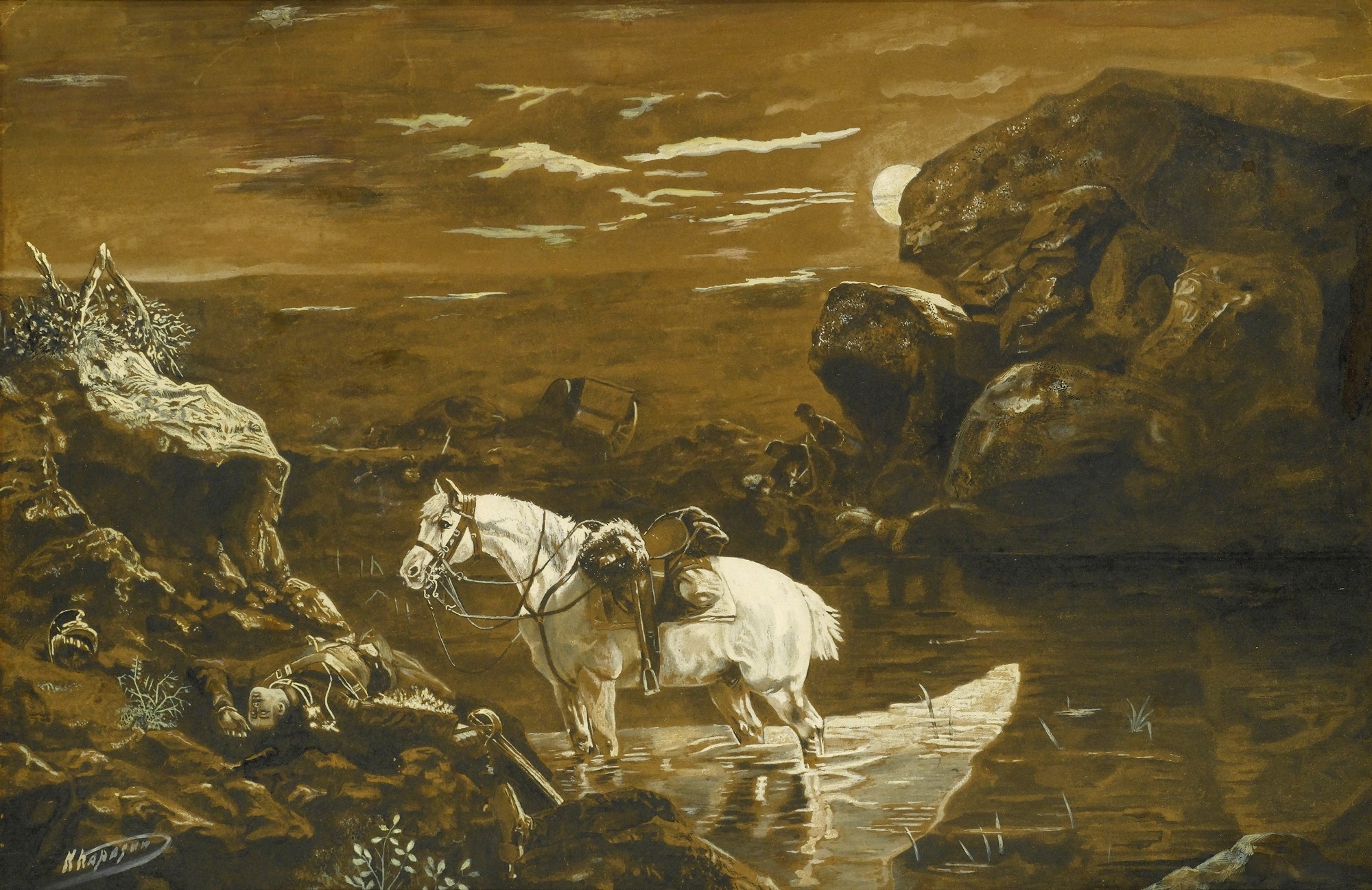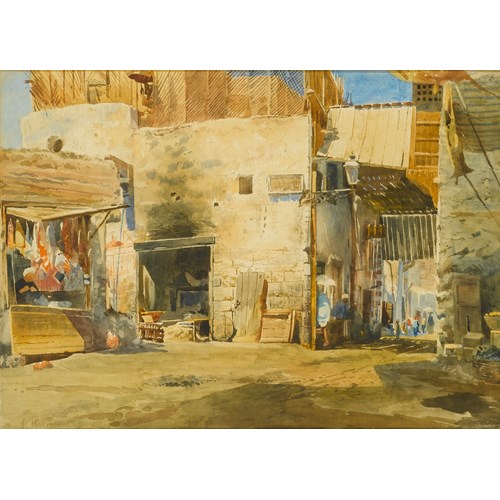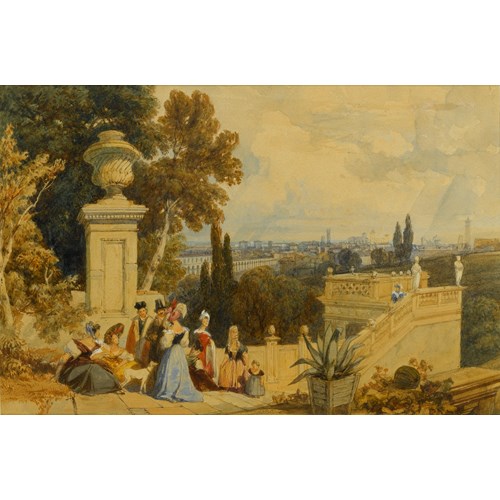Marketplace
Horse Watering at the Edge of a Battlefield
Nikolai Nikolaevich Karazin
Horse Watering at the Edge of a Battlefield
Epoque 1850-1900, 19th century, 20th century
Origine Russia
Medium Gouache on paper
Dimension 29.3 x 45.8 cm (11¹/₂ x 18 inches)
In this poignant work, a horse stands up to his knees in water, loyally waiting for his rider, who lies dead on the bank, a sword lying uselessly in his hand. The horse is depicted in an intense bright light, in contrast to the predominant browns and greys of the work and so immediately attracts the viewer’s attention. It takes a moment before one registers the prostrate body lying before its mount, and slowly details emerge from the gloom, such as the now redundant helmet and the abandoned cart on the far shore. There is another corpse on the far bank, over whom figures are bent, and this raises the question of whether these are people tending to the dead, or looters who will soon turn their attention to the body in the foreground. The overwhelming quiet, full moon, dead bodies, vast boulders and monochrome palette imbue the work with a slightly sinister air, and there is an incredible stillness in the aftermath of the recent battle.
Karazin explored the relationship between rider and horse a number of times in his work. In an illustration for Niva Magazine, a famous Russian periodical, the roles of rider and horse are reversed. Here, the figure stands over his mount, which has collapsed to the ground from exhaustion in the middle of a desert. The slightly helpless attitude of the figure is reminiscent of the horse in the present work. Karazin makes clear that their relationship is a mutually beneficial one, each relying on the other. In his illustration, the figure is clearly doomed now that he is stranded alone in the middle of a barren desert.
Military themes dominated Karazin’s work throughout his career, from large-scale history paintings to more intimate depictions of individual soldiers. At the age of twenty, he graduated from the Moscow Cadet School and stayed in the army for nine years, taking a two year hiatus in order to attend the Imperial Academy of Arts in St. Petersburg. He retired from military service in 1871, having experienced a number of military campaigns in a career for which he was officially recognised and rewarded for his exceptional bravery.
From this point, Karazin devoted himself entirely to art and literature. He wrote novels, both for adults and children, and ethnographic studies, and participated in scientific expeditions, but it was his artistic ability that secured his lasting reputation. He worked as a journalistic illustrator during several Russian campaigns, capturing a vivid and closely observed account of everyday life in the military, both during battle as well as when the soldiers were off-duty. Under imperial orders he created several large military canvases, but his real talent lay in small watercolours and drawings, in which his ability to make ordinary moments seem interesting and engaging shines through. As can be seen in the present work, he was able to dramatise his subjects through strong contrasts of light and dark and with simple, effective compositions. By the time he died in 1908, his talent had been widely recognised and rewarded by the Russian artistic community.
Karazin explored the relationship between rider and horse a number of times in his work. In an illustration for Niva Magazine, a famous Russian periodical, the roles of rider and horse are reversed. Here, the figure stands over his mount, which has collapsed to the ground from exhaustion in the middle of a desert. The slightly helpless attitude of the figure is reminiscent of the horse in the present work. Karazin makes clear that their relationship is a mutually beneficial one, each relying on the other. In his illustration, the figure is clearly doomed now that he is stranded alone in the middle of a barren desert.
Military themes dominated Karazin’s work throughout his career, from large-scale history paintings to more intimate depictions of individual soldiers. At the age of twenty, he graduated from the Moscow Cadet School and stayed in the army for nine years, taking a two year hiatus in order to attend the Imperial Academy of Arts in St. Petersburg. He retired from military service in 1871, having experienced a number of military campaigns in a career for which he was officially recognised and rewarded for his exceptional bravery.
From this point, Karazin devoted himself entirely to art and literature. He wrote novels, both for adults and children, and ethnographic studies, and participated in scientific expeditions, but it was his artistic ability that secured his lasting reputation. He worked as a journalistic illustrator during several Russian campaigns, capturing a vivid and closely observed account of everyday life in the military, both during battle as well as when the soldiers were off-duty. Under imperial orders he created several large military canvases, but his real talent lay in small watercolours and drawings, in which his ability to make ordinary moments seem interesting and engaging shines through. As can be seen in the present work, he was able to dramatise his subjects through strong contrasts of light and dark and with simple, effective compositions. By the time he died in 1908, his talent had been widely recognised and rewarded by the Russian artistic community.
Epoque: 1850-1900, 19th century, 20th century
Origine: Russia
Medium: Gouache on paper
Signature: Signed in Cyrillic (lower left)
Dimension: 29.3 x 45.8 cm (11¹/₂ x 18 inches)
Plus d'œuvres d'art de la Galerie









